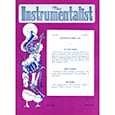In the past I have written in this column about the difference between hearing and listening. At the request of a reader, I would like to write about the differences between practicing, drilling and rehearsing.
Practicing
Practice is an on-going event done by you personally, alone in a practice room. It is a time when you work to perfect basic fundamentals, etudes, solos, and ensemble works. It is a time to strive to do your best. To practice is to repeat specific passages in various ways in order to conquer them. How you accomplish this might be called drilling because you repeat the passage, over and over, until you have taken possession of it.
Drilling with Rhythms
There are various ways to drill. Some performers apply rhythmic variations to a difficult passage, playing it in as many different rhythmic patterns as they can. Others work from the end of the piece to the front of the piece. For example, you play the last measure 10 times; then play the last two measures 10 times; and then the last three measures 10 times. This type of work ensures you know the end of the piece as well as you do the beginning. You could also use this method from the beginning of a piece, but our problems are rarely at the beginning. Personally, I like starting from the end because the natural instinct is to start working at the beginning.
Chunking
Some performers like to use the chunking technique when they practice. Chunking is a concept that I did not grow up with, but I have it on the best authority that it is a valuable practice technique. I was exposed to regrouping notes and practicing them in recognizable spurts and view this as a similar method to chunking. We called these Kincaid groups, in honor of the great William Kincaid, who had such an influence on the practice and phrasing of an entire generation of musicians. We regrouped notes so that the last three 16th notes of the beat led into the next downbeat, for example. If you practice the first movement of Bach’s A minor Partita regrouping all the sixteenth notes 2,3,4,1, the outcome is amazing. Not only are the notes more even with increased direction, the overall effect is more musical.
What Practice Is Not
Sometimes it is easier to explain what practice is not. Practicing is not playing something through three times and moving on. Every teacher has had students through the years who have said their band directors directed them to “Play you band piece through three times, and you can say you practiced.” That is absolute rubbish! Students cannot call this practice because they have not fixed any of the problem areas. If the purpose of practice is to improve musical and technical performance, some focused and concentrated listening are going to be necessary in order to hear what needs to be corrected.
It is also possible to mindlessly practice while thinking about any number of other things, like what you are going to wear tomorrow, or what you need to buy at the grocery store. This is not focused and concentrated listening either. It is mindless, ineffective practice because you are not thinking about what you are doing. Your mind is not in the practice room. You have to be mentally present and able to block out all other concerns in order to practice well and get something accomplished.
Rehearsing
A rehearsal is a specifically-timed event held in a rehearsal space in which you work with others. These times are not called Dress Practices, but are called Dress Rehearsals and are in effect a trial run for the performance. Ultimately musicians practice in order to learn music so they can rehearse it with other people who have been practicing the same music. At least two players are necessary for a rehearsal. For example, think of a flute choir. Flutists should arrive at the rehearsal with individual parts learned as well as possible. Trying to learn the music during the flute choir rehearsal is a waste of everyone’s time and patience. If everyone knows his or her part, the conductor can actually do something creative with an interpretation of the score, rather than simply teaching notes and rhythms.
With individual practice, the focus is more on musical accuracy and tempo, but when rehearsing with other musicians, goals change markedly. A simple read-through of a piece of music will quickly indicate where the attention should be.
Ensemble
Starting and stopping together, performing notes of the appropriate length, and playing together as one musician instead of many is the ultimate goal. I will never forget the first time I heard the Chicago Symphony perform. I was a student at Indiana University, and they came as part of the Artist Series there. The year had to be about 1964. I had never heard an orchestra of the quality of the CSO. I was knocked over by the ensemble; there were 110 musicians on the stage, and the overall effect was that of one musician making a singular blended sound that filled the concert hall.
Ensemble rehearsals are times to play the compositions while listening intently to the other musicians around you. That allows you to respond to their dynamic level, tone quality, intonation, and phrasing. That kind of listening makes tempo variations possible. Without that kind of listening, we might as well be performing the ensemble piece by ourselves; the other musicians being superfluous. Similarly, rehearsals allow us to become more familiar with the entire score so that when we practice during the week, we can hear the other musicians, even if they are not present.
I would like to thank the reader who wrote in with the question about the difference between practicing and rehearsing. We love to hear from readers. If you have a question, send it to: editor@flutetalkmagazine.com.





